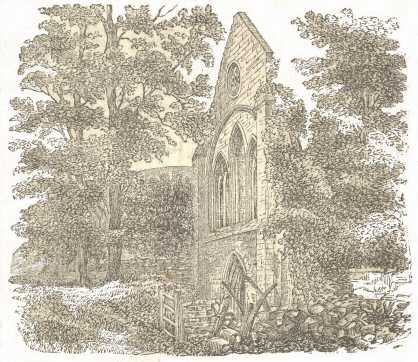Transcribed from the 1891 Hugh Jones,Llangollen, edition,
AN ACCOUNT
OF
VALLE CRUCIS ABBEY,
LLANGOLLEN.
And all the RecentDiscoveries.
Price Twopence.
LLANGOLLEN: PRINTED AND PUBLISHEDBY HUGH JONES.
1891.
p. 2ValleCrucis Abbey.
The venerable ruin of Abbey de Valle Crucis—in otherwords, Abbey of the Vale of the Cross, or, as the Welsh call it,Mynachlog y Glynn, Mynachlog Glynn Egwestl, Mynachlog LlanEgwestl, Mynachlog Glyn Eliseg, and Mynachlog Pant yGroes—is situated in a lovely and sequestered valley, abouttwo miles from Llangollen, on the right of the road towardsRuthin, and is approached by most delightful routes.
We go over the Dee Bridge and follow the road to the left, orwe may take a walk for about a mile along the canal side (reachedby the footpath leading through the wicket nearly opposite theRailway Station), passing over the third bridge, before reachingPentrefelin Slate Wharf, into the road again. About aquarter of a mile further on there is a gate leading to a fieldon the right, through which a path wends right to the grand oldAbbey. Those more inclined to drive the distance can havetheir demands satisfied at reasonable charges at the cab-standand the hotels; while to those who would prefer gliding along thesmooth water of the canal as far as Pentrefelin Wharf, ampleopportunity is afforded by pleasure boats, which run at intervalsdaily in that direction. Or the place may be reached bytravelling per rail to Berwyn Station, then crossing the Dee bythe Chainbridge, whence the distance to the Abbey is only half amile.
The sequestered spot on which was built the Abbey in the year1,200, by Madog ap Gruffydd Maelor, Lord p. 3of DinasBràn, and from which it takes its name, was known asPant-y-Groes, or the Glen of the Cross, long prior to thattime. It was so called from a very ancient inscribed pillaror cross, the mutilated remains of which stand in an adjacentfield.
The Abbey was dedicated to the Virgin Mary, and belonged to acommunity of Cistercian monks, an order founded in France in theyear 1098. The remains of the Abbey Church are the mostentire and picturesque part; but adjoining the southern side arethe remains of the Abbot’s lodgings, consisting of thechapter house and dormitories above.
The church was built in the form of a cross, which wascontrary to the form in common use prior to the twelfth century,and it is hence inferred that Madog availed himself of the aid ofthe Free Masons, as they were incorporated about this time, andwere the chief undertakers of such works. Sir ChristopherWren, in his Parentalia, describes their government as regular,and they were wont to make an encampment in huts. Asurveyor governed in chief; every tenth man being called a wardenand overlooking nine. They ranged from country to countryas they found churches to be built, and are supposed to havefirst introduced the cruciform style for religious edifices.
The eastern end of the church appears the most ancient, andthe three lancet-like windows have a very peculiar effect. The northern side has been almost destroyed, and there is novestige of the roof except in the eastern side of the southerntransept. The choir was w
